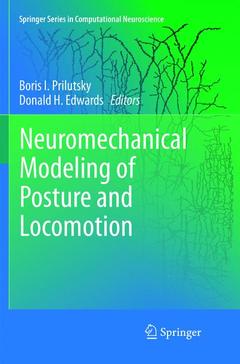Neuromechanical Modeling of Posture and Locomotion, 1st ed. 2016 Springer Series in Computational Neuroscience Series
Coordonnateurs : Prilutsky Boris I., Edwards Donald H.

Part I. Innovative modeling approaches in neuromechanical research
Chapter 1. Better science through predictive modeling: Numerical tools for understanding neuromechanical interactions - Nathan E. Bunderson and Jeffrey Bingham
Chapter 2. A neuromechanical model of spinal control of locomotion - Sergey N. Markin, Alexander N. Klishko, Natalia A. Shevtsova, Michel A. Lemay, Boris I. Prilutsky and Ilya A. Rybak
Part II. Organization of afferent signals, central neural circuits and the musculoskeletal system: Insights from neuromechanical modeling
Chapter 3. Neural regulation of limb mechanics: Insights from the organization of proprioceptive circuits - T. Richard Nichols, Nathan E. Bunderson and Mark A. Lyle
Chapter 4. Model-based approaches to understanding musculoskeletal filtering of neural signals - Thomas J. Burkholder
Chapter 5. Modeling the organization of spinal cord neural circuits controlling two-joint muscles - Natalia A. Shevtsova, Khaldoun Hamade, Samit Chakrabarty, Sergey N. Markin, Boris I. Prilutsky and Ilya A. Rybak
Chapter 6. Muscles: non-linear transformers of motor neuron activity - Scott L. Hooper, Christoph Guschlbauer, Marcus Blümel, Arndt von Twickel, Kevin H. Hobbs, Jeffrey B. Thuma and Ansgar Büschges
Part III. Neuromechanical modeling of posture and postural control
Chapter 7. Why i
s neuromechanical modeling of balance and locomotion so hard? - Jessica L. Allen and Lena H. Ting
Chapter 8. Neuromusculoskeletal modeling for the adaptive control of posture during locomotion - Shinya Aoi
Chapter 9. Model-based interpretations of experimental data related to the control of balance during stance and gait in humans - Robert J. Peterka
Part IV. Neuromechanical modeling of locomotion
Chapter 10. Computing motion dependent afferent activity during cat locomotion using a forward dynamics musculoskeletal model - Boris I. Prilutsky, Alexander N. Klishko, Douglas J. Weber and Michel A. Lemay
Chapter 11. Modeling and optimality analysis of pectoral fin locomotion - Xinmin Liu, Frank Fish, R. Scott Russo, Silvia S. Blemker and Tetsuya Iwasaki
Chapter 12. Control of cat walking and paw-shake by a multifunctional central pattern generator - Brian Bondy, Alexander N. Klishko, Donald H. Edwards, Boris I. Prilutsky and Gennady Cymbalyuk
Boris Prilutsky received his BS degrees in physical education and applied mathematics/ mechanics from Central Institute of Physical Culture in Moscow, Russia and Moscow Institute of Electronic Engineering, respectively, and a PhD in animal movement biomechanics and physiology from Latvian Research Institute of Traumatology and Orthopedics. He is currently an associate professor in the School of Applied Physiology and director of Biomechanics and Motor Control laboratory at the Georgia Institute of Technology and an adjunct associate professor in the Division of Physical Therapy at Emory University School of Medicine. His research interests are biomechanics and neural control of normal and pathological movement.
Donald H. Edwards received a B.S. degree in electrical engineering from the Massachusetts Institute of Technology and a Ph.D. in neurobiology from Yale University. He studied sensori-motor integration as a postdoctoral research associate with Donald Kennedy at Stanford University and with Brian Mulloney at University of California, Davis. He joined the faculty at Georgia State University as Assistant Professor of Biology and is currently Regents’ Professor of Neuroscience. His research interests include sensori-motor integration, neuromechanics and the neural control of behavior.
The first book on the topic of neuromechanics in general and on neuromechanical modeling of posture and locomotion specifically
Presents uniquely diverse modeling approaches
Covers a range of topics from theoretical studies to detailed neuromechanical models
Includes supplementary material: sn.pub/extras
Ouvrage de 368 p.
15.5x23.5 cm
Ouvrage de 368 p.
15.5x23.5 cm
